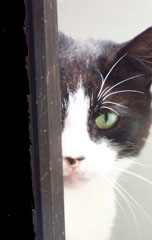 |
A functional account of Binocular Rivalry
When different images are shown to the two eyes, awareness can alternate such that each is intermittently suppressed and only one image is
seen at a time. For instance, a picture of a girl can be shown to the left eye and a picture of a house to the right. Perception can then
alternate - swapping between seeing the girl and the house. This phenomenon is called Binocular Rivalry. a rough simulation...
Binocular Rivalry has generated broad interest as it permits an opportunity to explore the relationship between changes in conscious vision and
brain activity in the absence of changes to sensory input. However, the function of binocular suppression remains a point of contention. even animals peek...
Arnold, D.H., & Wallis, T. (in press). Staying Focussed: A functional account of binocular rivalry. Proceedings of the Royal Society B.

The conditions necesary for Binocular Rivalry, seeing different images in the two eyes, may seem peculiar - but this often happens in daily life.
For instance, it can be advantageous to see without being seen. We often try to achieve this by
exposing the minimal bodily extent (one side of the head) necessary to see – we peek around corners. When both eyes are open, this creates a situation
wherein different images are seen at corresponding points in the two eyes.

As you can demonstrate for yourself, peeking does not cause Binocular Rivalry. When we peek we tend to focus on a
point of interest somewhere in the distance - not on the more proximate retinal image of the surface that we are peeking around, which appears
blurred as a consequence. When peeking, we also tend to see what is at the distant point of interest and tend only to be faintly aware of the more proximate
retinal image (of the surface that we are peeking around, the wall, the door, the tree, etc…).
We have shown, using a manipulation that ensures suppression is unambiguously related to a particular stimulus, that suppression during binocular rivalry is
determined by optics. Focused images tend to be persistently experienced whereas blurred images are suppressed. There is a smooth transition from the
near total suppression to the near complete perceptual dominance of an image as blur difference is changed. This shows that even slight blur differences
influence which image is seen during Binocular Rivalry - suggesting that the process(es) that cause almost complete suppression when we peek
around corners remain active during Binocular Rivalry.
Our data suggest that the fluctuations of perceptual dominance, that are characteristic of Binocular Rivalry, track the brain’s attempts to
determine which of two conflicting images is closest to the point of fixation.
For a full description of this research, please read the published account...